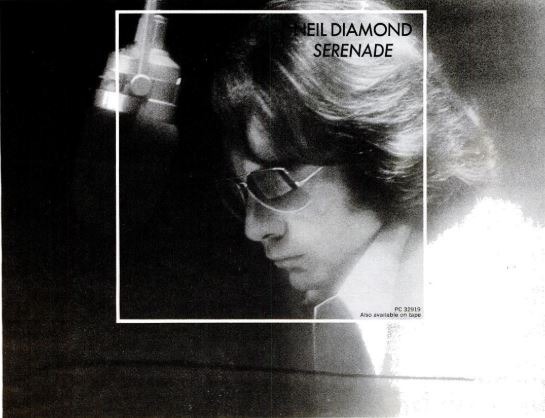Singer-songwriter-composer Neil Diamond has enjoyed a long career that boasts hundred million record sales to his name and numerous Billboard hit singles including his adult contemporary chart smashes.
He dropped out while he was a graduating student at New York University to accept an irresistible offer from a music publishing company. Diamond honed his songwriting craft, eventually producing hits such as “I’m A Believer” which was sung by the Monkees. Only in the 1ate 1960s did he begin recording, and made songs that would launch him to superstardom such as “Sweet Caroline”, “Cracklin’ Rosie”, “Holly Holly”, “Song Sung Blue” and “I Am… I Said”.
Diamond achieved further prominence and success during the 1970s as he performed to huge sell-out crowds, rom one of his gigs came to the formation of his 1972 double live album Hot August Night, which earned positive reviews and high record sales. Despite the success and legendary status, Diamond still actively records and tours up to this day.
Fated to be a Singer-Songwriter and Musician
The legendary singer-songwriter has his roots in New York, where he was born on January 24, 1941. His early interest was sports, particularly fencing. In fact, when he attended New York University, Diamond was awarded a fencing scholarship, specializing in saber. He even participated in NCAA’s fencing team during the 1960 championships.
Diamond’s first ambition was to become a doctor, wanting to discover a cure for cancer since his beloved grandmother had died of the disease. However, fate had other plans for him.
During his senior year at NYU, he was offered by a music publishing company Sunbeam Music to write songs for $50 per week. The offer was too much for Diamond to decline, so he took it right away.
He was trying to hone his songwriting craft until his hard work finally paid off. His composition “Sunday and Me” became a Top 20 hit for the Jay and the Americans in 1965. The following year Diamond was signed to Bang Records. He recorded his first LP The Feel Of Neil Diamond which produced singles such as “Solitary Man” and the #6 Billboard hit “Cherry, Cherry”. He also wrote hits for the Monkees such as “I’m A Believer” and “A Little Bit Me, A Little Bit You” (#1 and #2 on the Hot 100 charts, respectively).
On the Way to Superstardom
In the late 60s Diamond severed his ties with Bang Records and soon joined Uni record label in California, therefore he had to move to Los Angeles. From there he would make records that would put him to super-stardom. His subsequent records “Sweet Caroline”, “Holly Holly” and “I Am… I Said” became smashes and earned gold record status. While his other singles “Cracklin’ Rosie” and “Song Sung Blue” were #1 on the Billboard charts, thus consolidating Diamond’s star status.
The 1970s was a very good decade for Diamond. He performed to sold-out dates in Los Angeles and New York, and from one of his gigs came to the formation of his 1972 double live album Hot August Night, which earned positive reviews and high record sales. In Australia especially, where Hot August Night remained at #1 for an incredibly long period — 29 weeks. The live double album has become an enduring classic.
In 1973 Diamond returned to Columbia Records. Columbia was actually his first label where Diamond cut singles in the early 1960s; none of them hit the charts, the reason Columbia dropped him. This time, of course, things had changed. Columbia offered Diamond a lucrative contract — a one million dollar advance for every album he would record.
Some of his most famous and successful songs include:
- “Sweet Caroline” (1969): Perhaps Diamond’s most iconic song, it has become a timeless classic and is often sung at sports events and gatherings.
- “Cracklin’ Rosie” (1970): This was Diamond’s first American number-one single on the Billboard Hot 100 chart.
- “Song Sung Blue” (1972): A very successful single, it reached number one on the Billboard Hot 100 and remains one of his most popular songs.
- “Love on the Rocks” (1980): Featured in the movie “The Jazz Singer,” this song is known for its poignant lyrics and powerful delivery.
- “America” (1981): Also from “The Jazz Singer,” this patriotic song became very popular in the United States.
- “Hello Again” (1981): Another hit from “The Jazz Singer,” it’s a soft rock song that showcases Diamond’s unique voice.
- “I Am…I Said” (1971): This song was a top 5 hit in the US and reflected Diamond’s personal struggles with identity and belonging.
- “Cherry, Cherry” (1966): One of Diamond’s earlier hits, it’s an upbeat, catchy tune that remains popular.
- “Solitary Man” (1966): Diamond’s first charting single, it has been covered by many artists and is a staple of his live performances.
- “You Don’t Bring Me Flowers” (1978): A duet with Barbra Streisand, it became a number-one hit on the Billboard Hot 100.
Neil Diamond’s career has been marked by a distinctive voice, emotional songwriting, and a wide-ranging appeal, making him one of the best-selling musicians of all time. His songs have often been covered by other artists and remain enduring favorites across generations.
Other Commitments
Diamond also ventured on film scoring. His first essay in this department was to record a soundtrack for the 1973 film Jonathan Livingston Seagull. The soundtrack album also carried the same name. Though the film tanked at the box office, the album did very well commercially, peaking at #2 on the Billboard album charts. It also earned Diamond Grammy and Golden Globe awards for his work.
He continued to perform in full-house concerts, including his gig at the classy grounds of the Aladdin Hotel in Las Vegas, in conjunction to its opening of a new theater worth $10 million in construction. He was paid over half a million dollars by the hotel.
One of Diamond’s most memorable songs is the ballad “You Don’t Bring Me Flowers”. He wrote it with the famed husband-and-wife songwriting team Alan and Marilyn Bergman, and duetted with Barbra Streisand. There were plans of doing a film version of the song starring Diamond and Streisand, but they were on hold when he instead starred on another film The Jazz Singer, a remake of the Al Jolson 1927 classic. His performance led him to become the first-ever Worst Actor winner at the Razzie Awards in 1980; the film didn’t do well either.
His Legendary Status is Assured – Love Him or Hate Him
But it was fine, since Diamond wasn’t born an actor, and he instead focused his energies on recording songs for him and other artists as well and producing albums. Diamond would score more Top 10 singles such as “Love On The Rocks”, “Hello Again”, “America” and Heartlight. UB40 did a reggae cover of a Diamond original “Red Red Wine”, which shot to #1 on the UK and US charts. He also did covers apart from releasing albums containing new material, including well-received Christmas albums in during the 1990s.
Since the 1990s Diamond’s music has experienced a resurgence and found latter-generation fans. His old hit “Sweet Caroline” became a popular anthem among sporting fans, from Boston College Football to Red Sox Nation. Urge Overkill, Smash Mouth and another icon Johnny Cash began to do Neil Diamond covers, and Neil Diamond impersonators became comedy fixtures.
Whether you love him or hate him, one thing’s for sure, Neil Diamond’s influence and contributions to the music industry, as well as the songs themselves, will never be forgotten.


